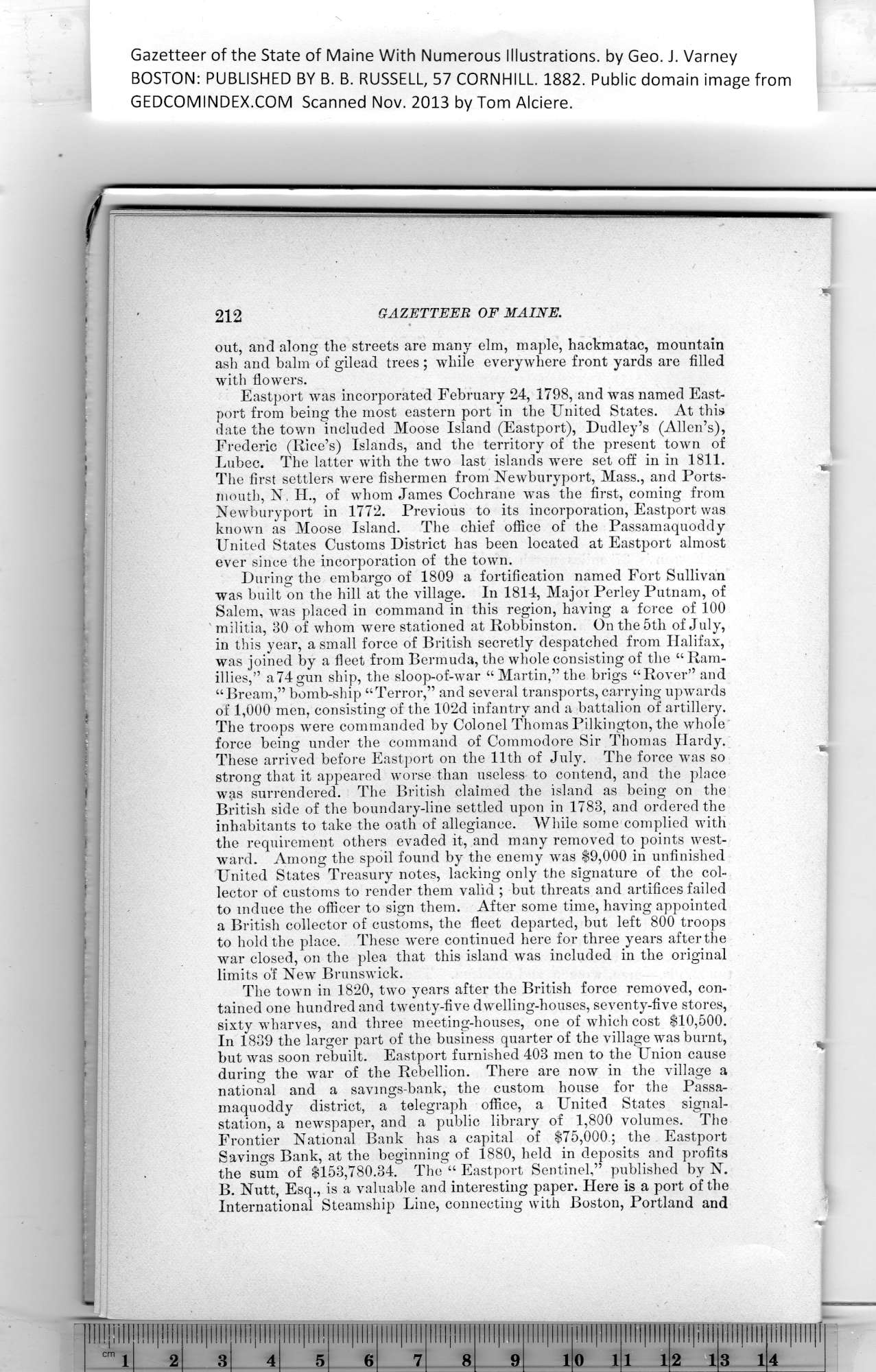|
Gazetteer of the State of Maine With Numerous Illustrations, by Geo. J. Varney
BOSTON: PUBLISHED BY B. B. RUSSELL, 57 CORNHILL. 1882. Public domain image from
212 GAZETTEER OF MAINE.
out, and along the streets are many elm, maple, hackmatac, mountain
ash and balm of gilead trees ; while everywhere front yards are filled
with flowers.
Eastport was incorporated February 24, 1798, and was named East-
port from being the most eastern port in the United States. At this
date the town included Moose Island (Eastport), Dudley’s (Allen’s),
Frederic (Rice’s) Islands, and the territory of the present town of
Lubec. The latter with the two last islands were setoff in in 1811.
The first settlers wrere fishermen from Newburyport, Mass., and Ports-
mouth, N, IT., of whom James Cochrane was the first, coming from
Newburyport in 1772. Previous to its incorporation, Eastport was
known as Moose Island. The chief office of the Passamaquoddy
United States Customs District has been located at Eastport almost
ever since the incorporation of the town.
During the embargo of 1809 a fortification named Fort Sullivan
was built on the hill at the village. In 1814, Major Perley Putnam, of
Salem, was placed in command in this region, having a force of 100
militia, 80 of whom were stationed at Robbinston. On the 5th of July,
in this year, a small force of British secretly despatched from Halifax,
was joined by a fleet from Bermuda, the whole consisting of the “Ram-
illies,” a74gun ship, the sloop-of-war “Martin,”the brigs “Rover” and
“Bream,” bomb-ship “Terror,” and several transports, carrying upwards
of 1,000 men, consisting of the 102d infantry and a battalion of artillery.
The troops were commanded by Colonel Thomas Pilkington, the whole
force being under the command of Commodore Sir Thomas Hardy.
These arrived before Eastport on the 11th of July. The force was so
strong that it appeared worse than useless to contend, and the place
was surrendered. The British claimed the island as being on the
British side of the boundary-line settled upon in 1783, and ordered the
inhabitants to take the oath of allegiance. While some complied with
the requirement others evaded it, and many removed to points west-
ward. Among the spoil found by the enemy was $9,000 in unfinished
United States Treasury notes, lacking only the signature of the col-
lector of customs to render them valid ; but threats and artifices failed
to mduee the officer to sign them. After some time, having appointed
a British collector of customs, the fleet departed, but left 800 troops
to hold the place. These wrnre continued here for three years after the
war closed, on the plea that this island was included in the original
limits o'f New Brunswick.
The town in 1820, two years after the British force removed, con-
tained one hundred and twenty-five dwelling-houses, seventy-five stores,
sixty wharves, and three meeting-houses, one of which cost $10,500.
In 1839 the larger part of the business quarter of the village was burnt,
but was soon rebuilt. Eastport furnished 403 men to the Union cause
during the war of the Rebellion. There are now in the village a
national and a savings-bank, the custom house for the Passa-
maquoddy district, a telegraph office, a United States signal-
station, a newspaper, and a public library of 1,800 volumes. The
Frontier National Bank has a capital of $75,000.; the Eastport
Savings Bank, at the beginning of 1880, held in deposits and profits
the sum of $153,780.34. The “ Eastport Sentinel,” published by N.
B. Nutt, Esq., is a valuable and interesting paper. Here is a port of the
International Steamship Line, connecting with Boston, Portland and
PREVIOUS PAGE ... NEXT PAGE
This page was written in HTML using a program written in Python 3.2
|
